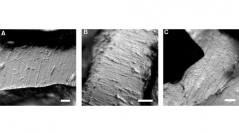

 Comptes Rendus Palevol
9 (8) - Pages 471-478
Comptes Rendus Palevol
9 (8) - Pages 471-478The site of La Milloque (Aquitaine Basin, south-western France), dated to the end of the Late Oligocene (MP29 reference level), has yielded an important fauna of mammals since its discovery in 1868. Notably, three different size species of Moschidae (Ruminantia) were identified at this locality: Dremotherium quercyi, Dremotherium guthi and Bedenomeryx milloquensis. Dental microwear analysis was used to determine their respective feeding preferences in comparison to various extant ungulates. The smallest one, D. quercyi, was close to leaf browsing extant species and to the mixed-feeding species Tragelaphus scriptus, and so fed mainly on leaves. The largest species D. quercyi and B. milloquensis showed affinities with grazing extant species, and so consumed grasses. Thus they constitute the oldest brachydont grazing ruminants analysed up until now. The results, in agreement with previous studies, imply the existence of a mixed environment at La Milloque, ranging from light forest to more open areas constituted of grasses.
La Milloque, Late Oligocene, Ruminants, Dental microwear, Feeding preference, Paleoenvironment, France